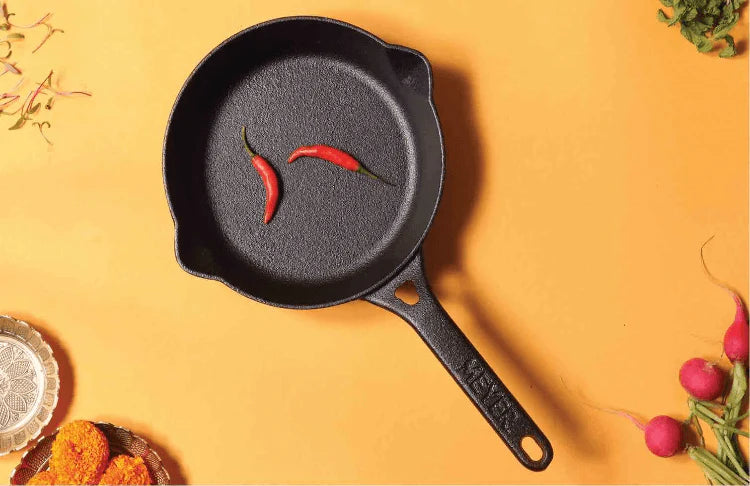



FAQs
Cast iron cookware is widely regarded as a healthy choice: it naturally enriches food with bioavailable iron—helpful in preventing or correcting iron deficiency—and, when properly seasoned, does not release any synthetic coatings or harmful chemicals into your meals.
Cast iron cookware is made from a specific type of cast iron alloy, predominantly composed of:
- Iron (≈ 93–98%)
- Carbon (2–4%): This higher carbon content imparts hardness and makes the alloy brittle but excellent for casting into durable cookware
- Silicon (1–3%): Enhances fluidity for easier pouring and supports the development of graphite flakes, which aid in seasoning and non‑stick behavior
- Trace elements: Such as manganese, sulfur, and phosphorus—added in small amounts to improve hardness, machinability, and casting performance
- Delicate or flaky foods (like soft white fish, scallops, tender eggs): these can stick and fall apart unless the pan is extremely well-seasoned
- Sticky, sugary sauces (e.g., candy, caramel, teriyaki, barbecue): they can quickly adhere and harden, damaging the seasoning layer
- Acidic dishes (tomato sauces, wine- or vinegar-based braises, citrus-heavy recipes): prolonged exposure can strip the seasoning and impart a metallic taste
- Strong-smelling or pungent ingredients (garlic, onions, smelly cheeses, fish): their odors can linger in the porous surface and affect future dishes
- Large quantities of liquid or braising: cast iron performs best when kept relatively dry—too much liquid can compromise seasoning integrity.
- Heavy and Awkward to Handle: Cast iron is significantly heavier than other cookware materials. A 10‑inch skillet can weigh 2 kgs, making it difficult to lift, flip, or transport—especially for those with limited strength or mobility.
- High Maintenance: Seasoning & Cleaning: It requires continual care—regular seasoning, hand-washing (no dishwasher), thorough drying, and light oiling. Without this upkeep, rust forms and the pan's non-stick surface degrades
- Slow, Uneven Heating: Cast iron heats slightly slowly and conducts poorly compared to aluminum or stainless steel. This means long preheat times and a risk of hot spots if not heated evenly
- Reactive with Acidic Foods: Cooking acidic ingredients (tomatoes, citrus, wine) can strip seasoning, cause metallic flavors, and discolor food. But this can be fixed by reaseasoning.
- Risk of Rust and Brittleness: If not dried properly, cast iron will rust. It's also brittle and can crack or chip if dropped or overheated
- Choose cast iron for long-lasting cookware that excels at high-heat searing, baking, and heat retention—and don’t mind the upkeep.
- If you prefer low-maintenance, lighter weight, non-reactivity, and precise temperature control for everyday cooking.
Both can be valuable in a well-rounded kitchen—your best choice hinges on what you cook most often and how much effort you’re willing to put into care.
Cast iron becomes black through a process of oil polymerization and oxidation that builds a protective, non-stick patina—this black layer guards against rust, improves cooking performance, and is a sign of a well-maintained pan.
Yes, you can use soap on cast iron—just keep it minimal. But if you're aiming to preserve every layer of seasoning, hot water and gentle scrubbing are often enough and help the pan age gracefully.
- Insufficient or uneven seasoning: A poorly seasoned pan lacks that slick, polymerized oil layer, so food adheres to exposed metal.
- Improper preheating: Cast iron must be heated slowly and evenly before cooking. Underheated pans cause food to stick; sudden hot spots do, too. Add your oil to the pan only when the pan is hot. Don’t add oil to a cold pan.
- Temperature mismanagement: Too low, and food clings; too high, and food burns onto the surface. Medium heat is ideal.
- Not enough fat or using excess oil: Too little oil offers no barrier; too much leaves sticky residues that aren’t polymerized.
- Cleaning or storage issues: Harsh cleaning can damage seasoning; leftover food or moisture can degrade it.
When evaluating the quality of a cast iron pan, look for these key indicators:
- Weight & Thickness: A good-quality cast iron pan feels dense and hefty—it should have real substance. Thicker walls and base (typically 5 mm or more) ensure excellent heat retention and even cooking. Lightweight or thin pans may be prone to warping and uneven heating.
- Flat, Smooth Surface: Inspect the cooking surface for a slight pebbled texture (from sand casting) that’s been tumbled or machined smooth—ideal for seasoning and non-stick performance. Avoid deep pits, rough spots, or overly shiny surfaces, which might indicate poor casting or an added non-stick coating.
- Even Cast & No Warping: Check for uniform thickness and shape. The pan should sit flush on a flat surface—use a card beneath it to test for wobble. Warped bottoms cause uneven heating and instability on modern cooktops.
- Integrated, Ergonomic Handles: High-quality pans cast handles in one piece—no rivets or welds, which can loosen or break under heat. Handles should be comfortably sized to grip with an oven mitt.
- Good Heat Performance: A test of quality: the pan should heat evenly and maintain temperature well once hot. Any noticeable hot spots or slow heat response can indicate inferior casting.
- Pre-seasoning & Surface Condition: New pans should come pre-seasoned, with a thin, even protective layer. Older or used pans should exhibit a smooth, dark patina (not flaky, rusty, or uneven). This helps prevent rust and aids non-stick performance







